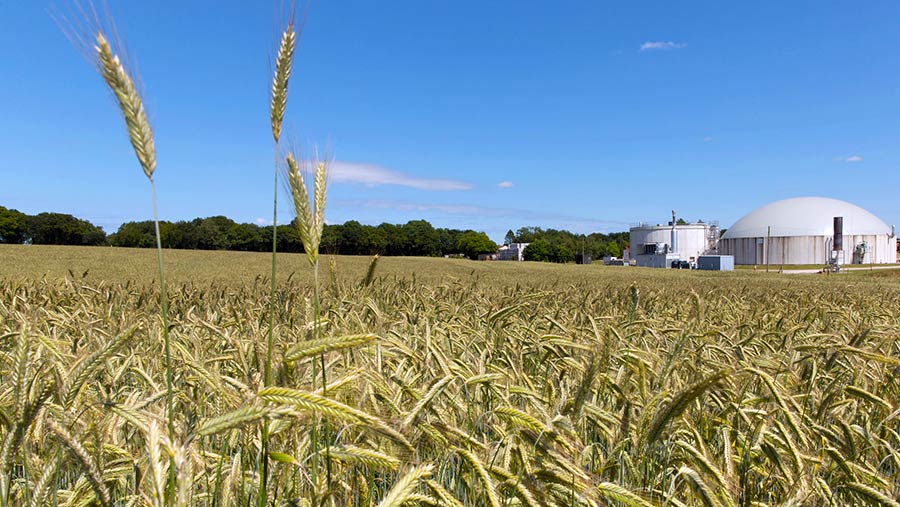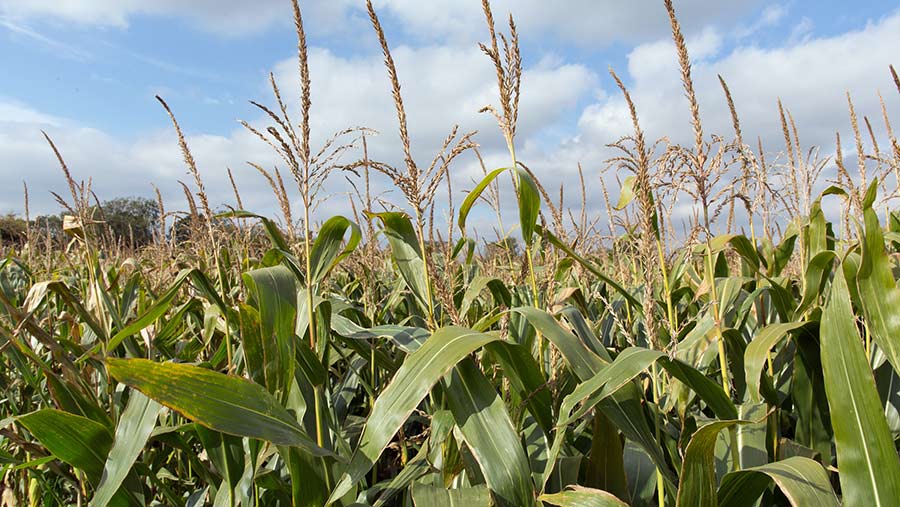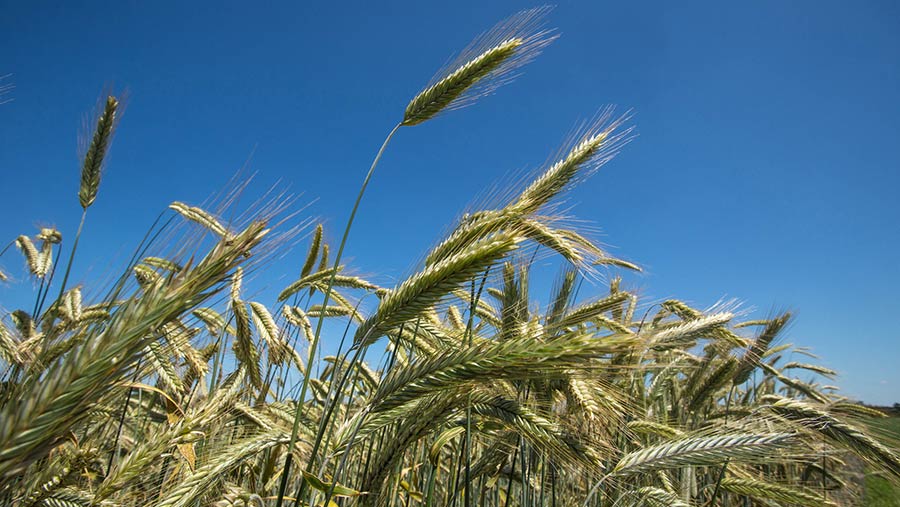Anaerobic digestion crops bring added value to farm’s rotation
Expanding the rotation to grow maize, rye and sugar beet for anaerobic digestion has brought greater profitability and fertiliser cost savings to an East Anglian family farm.
Anaerobic digestion has enjoyed a surge in popularity, with the crops grown specifically for bioenergy in the UK increasing more than threefold over the period 2008-2015 to 93,000ha.
One grower playing a part of this upward trend is Ian Hall, who farms with his family just outside the Suffolk market town of Beccles.

© Tim Scrivener
Mr Hall has worked to diversify, expand and add value to the family farm’s rotation with niche crops such as millet, naked oats, soya and hemp grown over the years.
See also: 5 monitor farmers share their cost saving tips
These have been planted alongside staple crops which include winter wheat, oilseed rape, sugar beet, maize, rye and spring and winter beans, grown on the 140ha home farm and 505ha of rented and contract farmed land.
When the Ellough AD plant, the biggest gas to grid digester in East Anglia, was built just a few miles from the farm gate in 2013, Mr Hall wasted no time in grabbing this emerging local market.
“The plant officially opened in September this year, but we have been supplying it since 2013. We started by growing just maize and then the beet and rye came later on,” he explains.

© Tim Scrivener
Mr Hall has since gone into partnership with his brother Tom and local contractor Adrian Smith to form Ellough Feed Stocks – the main supplier to this plant with a network of about 40 local farmers growing maize, rye and sugar beet to feed the five megawatt digester.
The company offers growers a package deal, where maize and rye is purchased as a standing crop with the harvesting and haulage of the crop to the AD plant included, bearing no cost to the grower.
Sugar beet is sold per tonne and lifting is done by each grower’s preferred contractor.
“The advantage of growing for AD is that it’s another crop in the rotation and has a known market price that doesn’t bounce up and down. It helps spread the workload across the year as well,” says Mr Hall.
Maize
The number one crop grown for digestion is maize, in fact 29% of the total maize area in England in 2016 was grown for use in AD; that equates to 1% of England’s total arable area.
Mr Hall says the attraction of maize is that it is already familiar to many growers and is a relatively low input crop.
“A big advantage of maize is that it is simple to grow. You plough, knock the seed-bed down, drill and apply a herbicide and then one fungicide, whereas wheat requires a lot more passes with the sprayer,” he says.
See also: 6-step guide to successful maize establishment
It also means that different herbicide actives can be used for more effective weed control, making it a good clean up crop.
He notes that an average maize crop yielding about 40t/ha has the potential to return upwards of £800/ha after variable costs, when using liquid digestate as the main source of nutrients with no associated harvesting costs to the grower.
Rye
As with maize, rye is a low input crop and it can potentially take the place of a second cereal in a farm’s rotation.
Mr Hall says last year rye seed cost him about £105/ha and he puts the total fungicide spend at about £35/ha with an additional £6/ha spent on plant growth regulation.
He says herbicide costs will vary greatly depending on weed pressure, but the crop is extremely vigorous and competitive in the spring.

© Tim Scrivener
Cheaper azole fungicides are used for brown rust and mildew control and plant growth regulator chlormequat is applied as a split application.
“Don’t go too mad with the growth regulation because you need that bulk, so just apply enough to stiffen the straw a bit,” he adds.
He says rye, maize and sugar beet are all helpful in the fight against blackgrass, but rye is especially handy because it is highly competitive and is cut before the blackgrass seed becomes viable.
“You’ve also got most of the chemical weed control options that you have for wheat and you don’t have to worry about keeping it quite as clean as wheat because it’s a forage crop.”
The rye typically gets cut in late June so, depending on which crop comes next in the rotation, it can either provide an early entry for oilseed rape or allow plenty of time to clear flushes of blackgrass in stale seed-beds.
Mr Hall has found that rye generally does well on both light and heavy land, but notes that it needs a quality seed-bed to get good establishment.
Sugar beet
While it won’t be for everyone, having sugar beet as part of a crop rotation means harvest is stretched out for longer into the autumn, rather than cramming more work into the same few months.

© Tim Scrivener
Mr Hall says sugar beet lifting times are flexible when growing for AD and the aim is simply to get a high fresh weight yield, rather than being concerned about amino acids and sugar content.
It also means that different modes of herbicide active can be used, helping in the fight against blackgrass.
Digestate savings
The digester that Ellough Feed Stocks supplies is fed a fixed daily ration of maize, rye and sugar beet year round, which means the levels of the various nutrients coming out of the plant in the form of liquid digestate are pretty consistent.
Mr Hall says the digestate delivers a good load of nutrients to his soils at a fraction of the price of bagged fertiliser.
See also: Tips and pitfalls of using digestate as crop fertiliser
Analysis done by charity Waste and Resource Action Programme found that the typical total nitrogen content of digestate is 5kg/t, of which 80% is readily available nitrogen.

© Tim Scrivener
Digestate also contains useful amounts of phosphate and potash, plus smaller amounts of other nutrients and trace elements.
“The value of the digestate is huge. It saves roughly £200/ha over bagged NPK fertiliser and you get those trace elements too. It is replacing what has been taken off at harvest.
“We apply the digestate at oilseed rape drilling for good establishment to help the crop grow away from flea beetle damage and get a good start. We also apply it to maize to get it off to a flying start,” he says.

